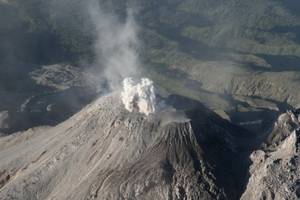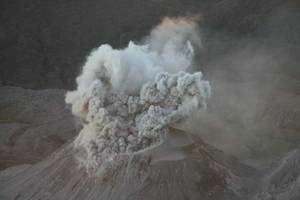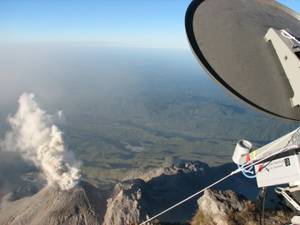Explosions at highly viscopus magmatic systems
Explosions at highly viscous magmatic systems: A case study of the eruption dynamics of Santiaguito volcano, Guatemala
Santa Maria volcano, Guatemala, and its dome Santiaguito, which is growing since 1922, are a “unique observation site” (Bluth and Rose, 2004) to investigate eruption processes directly at the vent. Standing on top of Santa Maria volcano (3772m asl) one has a clear view down the old horseshoe shaped scar onto Santiaguito volcano (~2500m asl) in its middle (see Fig. 1). Santiaguitos activity is mainly characterized through its explosive activity and its silicate-rich lava flows (viscosity ~ 4*109Pas, Harris et al., 2001). To better understand the eruption dynamics at such highly viscous systems a multidisciplinary experiment was carried out at the volcano in January 2007. Ground movement (seismic, Univ. of North Carolina), infrasound and highspeed video data (Univ. of New Hampshire), velocities and density of the erupted material (Doppler radar, Univ. Hamburg), and temperature of the eruption column (infrared camera, Univ. de Colima) were recorded simultaneously for 4 days. During those 4 days explosive activity with highly varying ash-content could be observed almost every hour (A. Gerst, 2007, pers. comm.). A total of about 140 eruptions were recorded using the Doppler radar system from us. We are currently in the process of analyzing all eruptions and sorting them into different eruption types, as well as concentration on eruption statistics (how many eruptions of which type).
What makes the eruptions at Santiaguito so special: About 50% of the eruptions are ring-shaped (Fig. 1). Bluth and Rose (2004) relate this shape to the geometry of conduit and vent. Given that the highest shear stresses in a flow are located at the conduit walls, and that high shear stresses cause magma fragmentation (Gonnermann and Manga, 2003) ring-shaped eruptions indicate a cylindrical conduit that is blocked by a lava plug. So far, numeric models for Santiaguito only deal with slowly rising magma (Barmin et al., 2002, Melnik and Sparks, 2005) and not with its explosive activity, eruption dynamics, and characteristics.
References:
Barmin, A., Melnik, O., and Sparks, R. J. S., 2002. Periodic behavior in lava dome eruptions. Earth Planet Sci Lett, 199:173–184.
Bluth, J. S. and Rose,W. I., 2004. Observations of eruptive activity at Santiaguito volcano, Guatemala. J Volcanol Geotherm Res, 136:297–302.
Gonnermann, H. M. and Manga, M., 2003. Explosive volcanism may not be an inevitable consequence of magma fragmentation. Nature, 426:432–435.
Melnik, O. and Sparks, R. S. J., 2005. Controls on conduit magma flow dynamics during lava dome building eruptions. J Geophys Res, 110:B02209. doi: 10.1029/2004JB003183.
Funding: PhD Stipend University of Hamburg
Contact: Lea Scharff, Alexander Gerst or Matthias Hort

- Top: Santiaguito dome, view from the summit of Santa Maria volcano. The photo shows the onset of a ring-shaped eruption.

- Middle: Further into one eruption

- Bottom: Observation of the eruption with the volcano radar.